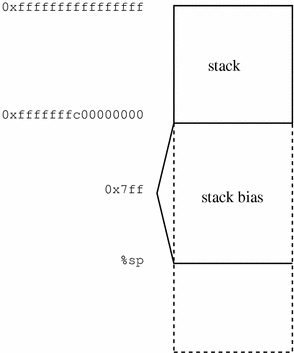ABI Features: SPARC V9
The SPARC Compliance Definition, Version 2.4, contains details of the SPARC V9 ABI. It describes the 32-bit SPARC V8 ABI and the 64-bit SPARC V9 ABI. You can obtain this document from SPARC International at www.sparc.com.
Following is a list of the SPARC V9 ABI features.
-
The SPARC V9 ABI allows all 64-bit SPARC instructions and 64-bit wide registers to be used to their full effect. Many of the new relevant instructions are extensions of the existing V8 instruction set. See The SPARC Architecture Manual, Version 9.
-
The basic calling convention is the same. The first six arguments of the caller are placed in the out registers %o0-%o5. The SPARC V9 ABI still uses a register window on a larger register file to make calling a function a "cheap" operation. Results are returned in %o0. Because all registers are now treated as 64-bit quantities, 64-bit values can now be passed in a single register, rather than a register pair.
-
The layout of the stack is different. Apart from the increase in the basic cell size from 32-bit to 64-bit, various "hidden" parameter words have been removed. The return address is still %o7 + 8.
-
%o6 is still referred to as the stack pointer register %sp, and %i6 is the frame pointer register %fp. However, the %sp and %fp registers are offset by a constant, known as the stack bias, from the actual memory location of the stack. The size of the stack bias is 2047 bits.
-
Instruction sizes are still 32 bits. Address constant generation therefore takes more instructions. The call instruction can no longer be used to branch anywhere in the address space, since it can only reach within plus or minus 2 Gbytes of %pc.
-
Integer multiply and divide functions are now implemented completely in hardware.
-
Structure passing and return are accomplished differently. Small data structures and some floating point arguments are now passed directly in registers.
-
User traps allow certain traps from non-privileged code to be handled by a user trap handler (instead of delivering a signal).
-
All data types are now aligned to their size.
-
Many basic derived types are larger. Thus many system call interface data structures are now of different sizes.
-
Two different sets of libraries exist on the system: those for 32-bit SPARC applications and those for 64-bit SPARC applications.
Stack Bias
An important feature of the SPARC V9 ABI for developers is the stack bias. For 64-bit SPARC programs, a stack bias of 2047 bytes must be added to both the frame pointer and the stack pointer to get to the actual data of the stack frame. See the following figure.

For more information on stack bias, please see the SPARC V9 ABI.
- © 2010, Oracle Corporation and/or its affiliates
